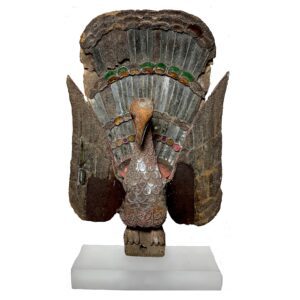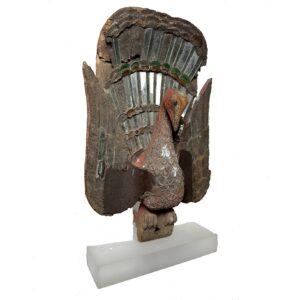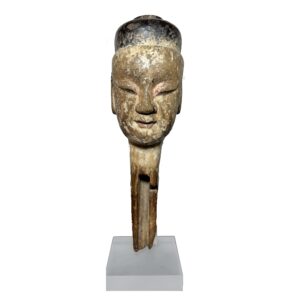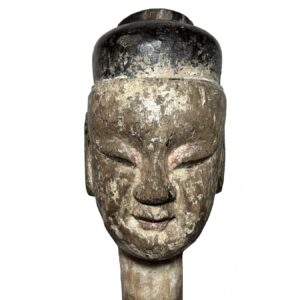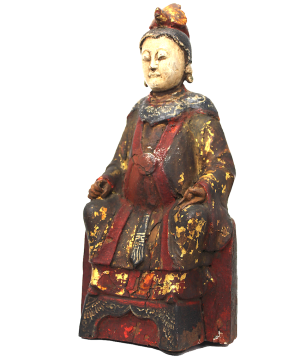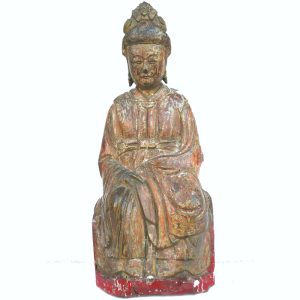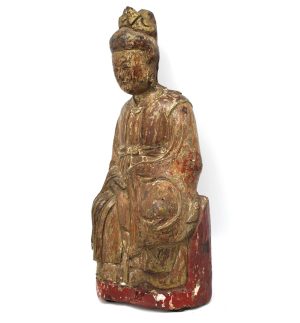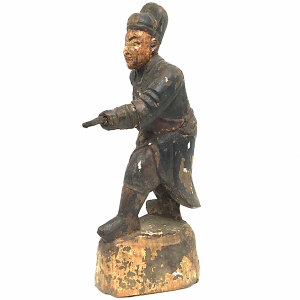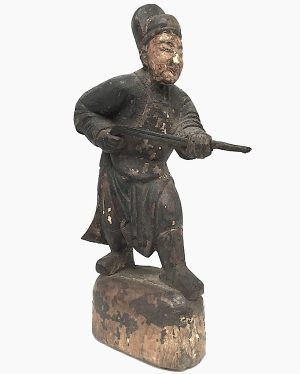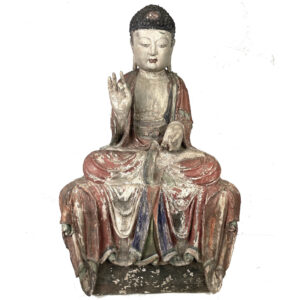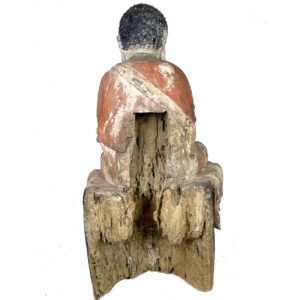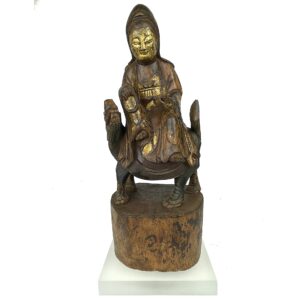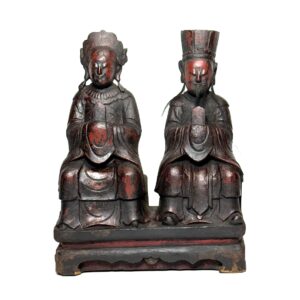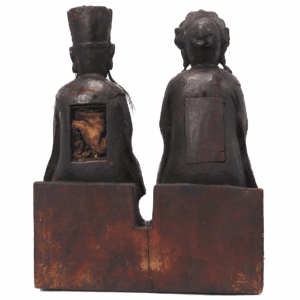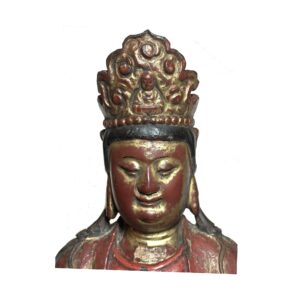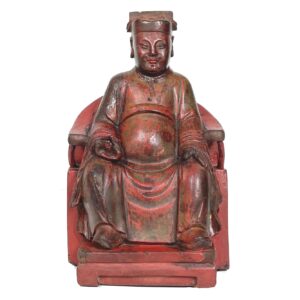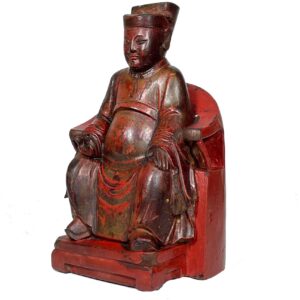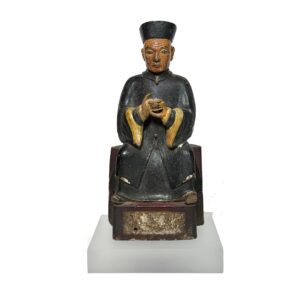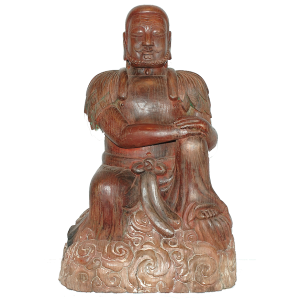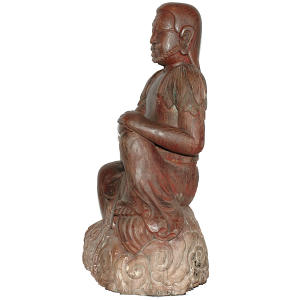Showing 73–84 of 169 results
-
Sale!


$725.00 Original price was: $725.00.$595.00Current price is: $595.00.
H: 16.5” W: 9.5” | 2.875” : | CALL 213-568-3030 OR EMAIL [email protected] FOR SHIPPING.
Carved Mandalay style peacocks with outspread feathers like this were placed over entrances to protect religious and government buildings. The peacock was emblem of last Burmese Dynasty symbolizing the monarchy descending from the sun.
-
Sale!


$495.00 Original price was: $495.00.$395.00Current price is: $395.00.
Ht: 22.25” W: 7.25” D: 5” | FREE SHIPPING WITHIN CONTINENTAL U.S.
This detailed male puppet head with a calm expression, round bun and half-smile was very versatile, used in religious or secular performances. Changing costumes and headgear, it could have been a Buddhist, Taoist or Popular Religion figure or deity or non religious character.
-
Sale!


$585.00 Original price was: $585.00.$395.00Current price is: $395.00.
H: 11.5″ W: 5.3″ D: 4.2″ | FREE SHIPPING WITHIN CONTINENTAL U.S.
Provincial carving with iconic phoenix headdress, hands in karana mudra to cast out demons, negative energy and purify spaces. Image was on home altar and consecrated with a sealed cover.
-
Sale!


$525.00 Original price was: $525.00.$295.00Current price is: $295.00.
H: 11.25″ W: 4.6″ | 3.25″ FREE SHIPPING WITHIN CONTINENTAL U.S.
Dense hardwood Queen Mother carving with phoenix in crown, holding robe across body, calmly seated on backless throne, much original polychrome and lacquer finish remains. Sealed consecrated cavity.
-
Sale!


$315.00 Original price was: $315.00.$275.00Current price is: $275.00.
H: 9 ” W: 3.625″ D: 3.5 ” | FREE SHIPPING WITHIN CONTINENTAL U.S.
Unique ancestor figure of a huntsman in the round standing on a domed pedestal, holding a flint lock, wearing a hunting coat, a two-level hat, traditional under- and outer-garment, and thick boots.
-
Sale!


$4,500.00 Original price was: $4,500.00.$3,300.00Current price is: $3,300.00.
H: 30″ W: 18″ D: 10″ | | CALL 213-568-3030 OR EMAIL [email protected] FOR SHIPPING.
Superb, colorful and rare Buddha in teaching (vitarka) mudra appears to float above swirling cloud. Fine features, graceful body and exquisitely rendered drapery make this a truly striking statue. Given its size and masterful carving, it should be revered commensurate with its spirituality and artistry.
-
Sale!


$725.00 Original price was: $725.00.$585.00Current price is: $585.00.
H: 15.125” W: 6” D: 5” | FREE SHIPPING within Continental U.S.
Rare provincial carving of Guanyin in lalitsana clasping a rosary on a mythical Hǒu that symbolizes righteousness, morality and ushers in peace and prosperity. Small yet powerful, consecrated and mounted on Acrylic base.
-
Sale!


$995.00 Original price was: $995.00.$695.00Current price is: $695.00.
H: 10″ W: 7.75″ D: 8.25″ | FREE SHIPPING WITHIN CONTINENTAL U.S.
Rare single image of Kitchen God and wife, indicating their close/lasting relationship as family’s protectors. Detailed elaborate officials’ robes, headgear. Individually portrayed holding hu tablets like those held by high court officials or Taoist priests.
-
Sale!


$3,750.00 Original price was: $3,750.00.$2,900.00Current price is: $2,900.00.
H: 19″ W: 10″ D: 8″ | CALL 213-568-3030 OR EMAIL [email protected] for shipping INFORMATION.
Wonderfully carved Nanhai Guanyin with ornate and beautiful diadem centered by elaborately framed Buddha Amitabha in meditation. Vibrant aura radiates spirituality, opulence, serenity and strength, as well as compassion and grace, making this a truly masterful piece of art.
-
Sale!


$650.00 Original price was: $650.00.$385.00Current price is: $385.00.
H: 7.25” W: 4.625” D: 3.5” | FREE SHIPPING WITHIN CONTINENTAL U.S.
Finely carved ancestor displaying status symbols: official’s attire and hat, horseshoe chair with feet on pedestal. Painted and lacquered front and back in red, traces of gilt, colors of “fu” as a wish for wealth, health and long life, aged from years of use into a great patina.
-
Sale!


$675.00 Original price was: $675.00.$495.00Current price is: $495.00.
Ht: 9″ W: 5″ D: 3.5″ | FREE SHIPPING WITHIN CONTINENTAL U.S.
Masterfully crafted Taoist official with calm, sincere and expressive face with creases indicating his age and wisdom of his senior status. Holds ritual cup with the elixir of immortality, a wish for a long and happy afterlife. Mounted on an acrylic stand.
-
Sale!


$4,600.00 Original price was: $4,600.00.$3,900.00Current price is: $3,900.00.
H: 30.5″ W: 19.25″ D: 11.75 | CALL 213-568-3030 OR EMAIL [email protected] FOR SHIPPING
Masterful carving of Shen Nong, revered hero and reputed father of both Natural Medicine and Agriculture. Benevolent, sitting on cloud, leaves on shoulders. One of 3 sovereigns who contributed to well-being of humanity. Especially fitting for health care, pharmaceutical or agricultural professional or associated with tea.
End of content
End of content

